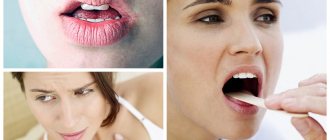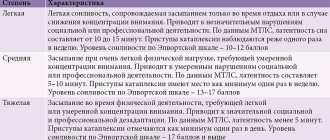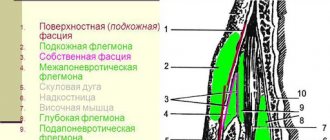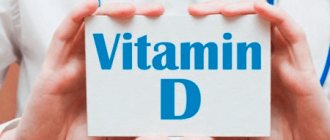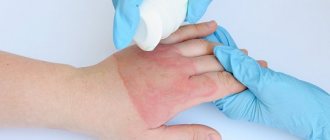Author Tatyana Otradnaya
04/08/2004 09:10 (Updated: 05/12/2021 14:32)
Health » Health and prevention » Prevention
New methods of treating various diseases using cold compresses are becoming increasingly common in home physiotherapy. The head of the therapeutic department of Moscow polyclinic No. 122, Alexander Grigoriev, talks about them.
Cold compress
Wet cold compresses: indications for use
— Alexander Alexandrovich, what explains the effectiveness of cold compresses?
“They cause local cooling, which is soon compensated by the body’s reaction to the stimulus: small arteries in this area of the body dilate, and thanks to the increased blood flow, the patient no longer feels cold, but a pleasant healing warmth. This occurs approximately five to eight minutes after applying the compress.
If after this time the patient continues to feel chills, it means that the blood vessels did not respond to the cold - there is not enough energy in the patient’s body to restore heat. Therefore, this method of physiotherapy cannot be used to treat emaciated or severely weakened people.
Cold compresses not only have a local effect - relax muscles, reduce pain, but also have a beneficial effect on the condition of the body as a whole, helping to cure many acute and chronic diseases.
However, cold compresses should not be considered a panacea for all ailments. They are good mainly as an addition to the treatment prescribed by the doctor.
— How can we explain that this effective treatment method has appeared only recently? Couldn’t they have thought of it earlier?
— Indeed, it is new only in our Russian medicine. Cold compresses were “invented” back in the last century by the German monk and healer Sebastian Kneipp , and since then they have been successfully used by his followers in some clinics in Germany. Presumably, they began to be used in our country thanks to the increasing number of trips abroad by Russian doctors in recent years.
The fact that not all Russians can afford medicines today also played a role - so doctors have to turn to non-medicinal methods - remember the well-forgotten old things, take an interest in the experience of foreign colleagues.
Applying a warm compress
The heat generated by the warming therapeutic bandage causes local dilation of blood vessels. Due to this, blood circulation in the tissues increases and metabolism accelerates. During the inflammatory process in this area, the use of a warming bandage has an analgesic and absorbable effect.
Warming compresses are used to dissolve accumulations of blood and lymph in tissues, for example, after injections. This type of treatment is excellent for treating muscle and joint diseases.
Contraindications to the use of a warming compress are skin lesions, purulent skin diseases, and boils.
Apply wet cold compresses yourself
— How to make cold compresses at home?
— The compress consists of two main layers:
- moist internal, which is applied to the body,
- dry external, the purpose of which is to retain heat.
And some doctors recommend placing a waterproof plastic film between these two layers.
The inner layer should be made of thin material that absorbs moisture well. For this, they usually use old sheets that you don’t mind cutting.
For the outer layer, denser fabrics are suitable - cotton wool, flannel. Instead, you can use a folded lightweight sleeping blanket. The outer layer should protrude beyond the edges of the inner layer by one to two fingers.
Before applying a compress, a very important condition must be met: warm up the patient . To bring in heat, take local baths with a gradually increasing temperature, and apply warm heating pads to your feet. This, of course, is not required if the patient has a high temperature and a compress is applied in order to lower it.
The inner layer of the compress is moistened with tap water and squeezed out a little.
For a moderate compress, you need to squeeze it harder - it is easier for the body to warm up tissue that does not contain too much water than completely wet one.
The most common position for the patient when applying a compress is lying down.
- First, an outer fabric that retains heat is spread on the bed and smoothed out well.
- Then a moistened cloth is placed on it.
- The patient lies down on them, and one or another part of his body is quickly and tightly wrapped, avoiding the formation of folds and “air pockets,” in a damp cloth, and then in an insulated dry one.
- Its edges are pinned with two safety pins across the tension of the material.
- After this, the patient is well wrapped.
- After removing the compress, the part of the body on which it was applied is washed with warm water and the skin is wiped dry.
Wet cold compress
Usually the compress is applied for 45 minutes - 1 hour, but there are exceptions to this rule. For more intense heat removal, you just need to wring out the sheet a little so that there is more water left in it, and after a quarter of an hour, apply a fresh compress to this area. And for long-term relaxation, the compress is kept for several hours and, if it is not too burdensome for the patient, even left overnight.
Possible contraindications
Warming in the form of a compress can only be used during the recovery stage or when the disease is at the initial stage of its development. In the event that otitis media has already become purulent, then using a compress will only help accelerate the development of bacteria, since a warm environment will facilitate the process of their reproduction. It is strictly forbidden to use an alcohol compress in the following situations:
- purulent processes,
- child's age up to 4 years,
- elevated temperature,
- atherosclerosis,
- inflammation or damage to the skin near the ear,
- boil, which is localized in the ear canal,
- presence of allergies to certain components of the compress,
- mastoiditis,
- eczema and dermatitis,
- fungal ear diseases.
In addition, there are absolute contraindications, which include epilepsy and convulsive syndromes.
Where to apply the compress: rules
— On what parts of the body are cold compresses most often applied?
- It depends on the illness that the patient suffers from.
Compresses on the chest
For acute or chronic bronchitis, pneumonia, back pain arising from spinal disease, compresses are applied to the chest.
The inner layer requires a strip of fabric 35 cm wide and a length, depending on the patient’s build, from 125 to 180 cm. It is very important to achieve the correct tension. It is best to apply the compress while half-exhaling - then it will not be too tight on the chest when you inhale and will not loosen too much after exhaling. Care must also be taken to ensure that the upper edge of the compress does not cut into the armpit.
In some cases, compresses are made that cover not only the chest, but also the shoulders. This is required for diseases in the area of the tops of the lungs or for painful tension in the muscles of the shoulder girdle, which often occurs in people who have been sitting in a tense position for a long time at a computer or driving a car.
And then a shoulder compress is applied on top of the chest compress and connected with pins. If such compresses have to be done frequently, special shoulder “straps” are sewn to the middle of the strip of the inner fabric of the chest compress - strips 15 cm wide and approximately 80 cm long.
Or you can do it differently: instead of inner fabric, use an old men's shirt with short sleeves, cutting it to the middle of the chest, and put on a warm pullover over it.
Compresses on the stomach
Apply for ulcers of the stomach and duodenum, inflammation of the bile ducts and pancreas, mucous membranes of the stomach and intestines.
For them, fabric strips 25 cm wide are used. They are applied for a long time, including at night. In addition to their main purpose, such compresses have a general relaxing effect on the body and, as research results have shown, quite significantly reduce high blood pressure.
Is the compress really effective?
Alcohol compresses are a treatment method that is often used not only by traditional healers, but also prescribed by doctors. It is quite simple to use, but there must be control. Its main task is to warm the ear in order to speed up metabolism and improve blood circulation. With its help, you can reduce pain and make it not as severe as it seems. By accelerating blood flow, toxins are quickly removed from the site of inflammation, as well as the effectiveness of the medications used increases.
All processes associated with healing are an order of magnitude faster. This compress is used most often for chronic non-purulent and acute otitis media. In addition, it can be used if discomfort is observed during the treatment of upper respiratory tract diseases.
compress on the ear, what to do
Warming alcohol compress
Alcohol compresses are used to resolve inflammatory infiltrates. They cause long-term and persistent dilation of superficial vessels. Blood circulation increases, resorption occurs in the source of inflammation and the underlying tissue. Pain sensations decrease.
The procedure for applying an alcohol dressing is almost identical to applying a wet hot dressing. A cloth or gauze should be moistened in vodka, salicylic or camphor alcohol. Or use any other medicinal alcohol infusion.
In exceptional cases, you can apply a compress with a weak vinegar solution.
To apply an alcohol dressing, the fabric must be moistened with the prepared solution and wrung out well. Apply to the sore spot, put cellophane and cotton wool on top. Remember that each subsequent layer must be larger than the previous one.
The area of the alcohol dressing should be carefully bandaged.
If the fabric of the first layer has dried before 6 hours, it should be removed. Before replacing a used bandage with a new one, the area where it was applied should be washed well with warm water. This will help avoid irritation.
How to make a warm compress
A wet hot therapeutic bandage is used to resolve areas of local inflammation.
The warming compress consists of three layers. The bottom layer is gauze soaked in a hot medicinal solution, folded in several layers. You can also use any cotton fabric.
A piece of waterproof material (oilcloth, plastic film larger than the first layer) should be placed on the bottom layer.
The top layer is a thick layer of cotton wool or woolen fabric. This layer should be larger in size than the previous two layers.
If the compress is applied correctly, its inner layer remains moist all the time. If the dressing is not applied correctly, or when the second or third layer does not completely cover the wet layer, active evaporation occurs. Instead of warming, this bandage cools the body.
Stages of the procedure
✔ Moisten a fabric napkin made of natural material (you can use regular gauze or a bandage) in hot water, hot infusion of medicinal herbs. ✔ Wring out the napkin well. ✔ Apply a moistened napkin to the desired area of the body. ✔ Place oilcloth or cellophane film tightly over the fabric. ✔ Place cotton wool or warm woolen fabric (shawl, scarf) on top of the film.
Topical therapy for skin diseases
N
It is impossible to imagine the treatment of dermatoses without the use of external agents. In some cases, they become of paramount importance, which is why it is so important to navigate the sea of medications that are constantly arriving on the market.
General principles for the use of external agents
Before carrying out external treatment, it is necessary to take into account the stage of the disease, the age of the patient (children, as a rule, are prescribed less irritating drugs in lower concentrations), and tolerability of the drug.
The effect of external treatment is more pronounced if the therapy is carried out comprehensively.
Powders
have a cooling effect on the skin, resulting in calming of burning and itching. During macerations from exposure to sweat, urine, and skin hyperemia, they also have a good effect. Powders are based on plant or mineral powders.
Aqueous solutions of medicinal substances are most often used in the form of lotions, wet-dry dressings and warm compresses
.
A piece of gauze folded in 4-5 layers and soaked in a cooled solution is applied to the affected area of skin. As it warms up, every 15-20 minutes, it is moistened again. This procedure lasts 1-1.5 hours, after which you should take a break for 1-2 hours. Due to the evaporation of water, the lotions
sharply cool the skin and cause a narrowing of blood vessels. This allows the use of lotions for acute inflammatory skin lesions, severely hyperemic, with swelling and weeping.
| Lotions reduce burning, itching and maceration phenomena |
A wet-drying dressing
is applied as follows: gauze folded in 4-5 layers, soaked in an appropriate solution, is applied to the affected area of the skin, covered with a thin layer of absorbent cotton wool and bandaged. The dressing is changed as it dries (usually after 3-4 hours), the slowly evaporating liquid cools the skin, like a lotion, only less actively, helps to subside the symptoms of acute inflammation, which is indicated in the treatment of subacute inflammatory processes accompanied by weeping. Depending on the medications included in the lotion, it has an astringent, disinfectant, drying effect, and in general an anti-inflammatory effect.
Warming compresses
act on the skin with moist heat and are used mainly in the treatment of chronic inflammatory processes. By causing active hyperemia, they increase metabolic processes in the affected area of the skin and help resolve the inflammatory infiltrate.
In addition, various antipruritic, antimicrobial and fungicidal solutions, which can be aqueous or alcoholic, are used externally. Alcohol solutions include solutions of boric and salicylic acids, resorcinol, lapis, iodine, aniline dyes, etc. Ethyl alcohol can cause skin irritation and have an astringent effect, which leads to drying, so its most desirable concentration is 70%.
Shaked suspensions, or “chatterers”
, are used for inflammatory and acute inflammatory (non-wetting) skin diseases (eczema, dermatitis, itchy dermatoses, etc.). Before use, they should be shaken to evenly mix all the ingredients - fine powdery substances that are suspended in water with oil or glycerin. The liquid part of the mash evaporates soon after lubricating the skin with it, and the powdery substances are deposited in a thin layer and are retained on it for a long time. In most cases, chatter is prescribed in equal parts - talc, zinc, glycerin and distilled water when a surface effect is needed. More liquid (up to 50-60%) is added to obtain a cooling effect and, conversely, 20-40% of liquid is taken to create a protective film on the skin. If the patient has dry skin or long-term exposure to the drug is required, it is recommended to prescribe oil suspensions. To speed up drying and enhance the effect, up to 10% alcohol or ichthyol, sulfur, menthol, anesthesin, tar, etc. are usually added to the “talkers”.
Pastes
used when there is a serous crust on the skin (in patients with eczema), for hyperemia (in patients with dermatitis), etc. The paste consists of equal parts of powder and fatty bases, has a dough-like consistency, and penetrates deeper into the skin than powders and mash. Depending on the composition (naftalan, sulfur, tar, lanolin, petroleum jelly), it acts as a cooling, softening and anti-inflammatory agent. The paste protects the skin well against abrasions after acute inflammatory phenomena have subsided.
Ointments
can be official (sulfuric, ichthyol, naphthalan, etc.) or prepared in a pharmacy according to a prescription. Animal and vegetable fats, oils, petroleum jelly, lanolin are usually used as a base, with the addition of various medicines. Ointments can be exfoliating, itching, epithelializing, softening, absorbing, etc.
In addition, medicinal varnishes and plasters
(for the treatment of condylomas, warts, calluses, onychomycosis), made on the basis of collodion, gelatin or lead plaster with the addition of the necessary medicinal substances.
Of course, all the previous well-known ointment products, including the so-called “complex” ones, manufactured to order, have not lost their relevance at all. However, the rhythm of life requires minimal time investment, and ready-made funds are of increasing interest.
Anti-inflammatory drugs
A review of local therapy can begin with drugs used in the treatment of allergic diseases. Allergic dermatoses require the use of different agents at different phases of the disease. In the presence of weeping lesions, lotions are recommended - boron, resorcinol, soda, with tannin - up to 3% - 5% of the active substance, as well as pastes from the above products, with the addition of naphthalan, tar, ichthyol, etc. After the acute weeping processes subside, sequence of ointment forms: flumethasone
(Lorinden), etc.
Among the monocomponent drugs for external use with anti-inflammatory effects, the following drugs have proven themselves well.
Hydrocortisone 17-butyrate
(locoid) - ointment, cream, lipocrem, lotion 0.1% - is an active synthetic non-halogenated glucocorticoid drug for topical use. Has a rapid anti-inflammatory, anti-edematous, antipruritic effect. Used for superficial, non-infected skin diseases - eczema, dermatitis, psoriasis; Apply to affected skin 1-3 times a day. Ointment and lipocrem provide good occlusive and hydrating properties in combination with the cosmetic appeal of the cream. For weeping skin diseases, it is advisable to use dosage forms such as lotion and crelo. The latter, having the properties of cosmetic milk, is especially effective for application to extensive skin lesions, as well as to the scalp.
| Lotions are used for acute inflammatory skin lesions with swelling and weeping |
Elokom - 1 g of cream or ointment contains mometasone furoate
1 mg; in tubes of 15 g; 1 ml of lotion for external use - 1 mg in an aqueous-alcohol solution; in bottles of 20 ml. Has anti-inflammatory, antipruritic effect. Ointment and cream are used for psoriasis, atopic dermatitis, lotion - for lesions of the scalp, rubbing a few drops of lotion once a day.
Betamethasone valerate
(Celestoderm B) - ointment and cream, 15 g each in tubes. Has anti-inflammatory, anti-allergic effects; eliminates swelling, hyperemia, itching at the site of application. Indicated for psoriasis, eczema, nodular prurigo, dermatitis, discoid lupus erythematosus, insect bites, generalized erythroderma. The effect of the drug can be enhanced by covering the treated surface with an occlusive dressing. The product is applied to the affected area 2-3 times a day until improvement, then used 1-2 times a day.
When the course of dermatoses is complicated by a secondary infection
I use products with antimicrobial and anti-inflammatory effects. Of the ready-made drugs, aerosols Oxycort T (hydrocortisone + oxytetracycline), Polcortolone (triamicilone + tetracycline), Oxycyclosol (prednisolone + oxytetracycline) provide invaluable assistance for dermatoses complicated by secondary infection.
Diprogent
— 1 g of ointment or cream contains betamethasone dipropionate 0.5 mg (0.05%) and gentamicin sulfate 1 mg (0.1%) in tubes of 15 and 30 g. It has anti-inflammatory, antipruritic, antiallergic, antibacterial effects. Inhibits the growth of gram-positive and gram-negative microorganisms, including staphylococci resistant to penicillin, Proteus, E. coli, salmonella, etc. Indicated for psoriasis, contact and atopic dermatitis, eczema (including microbial), dyshidrosis, itching of the anus and external genitalia organs.
Celestoderm B with garamycin
— 1 g of cream or ointment contains 1 mg of betamethasone valerate and 1 mg of gentamicin sulfate, in tubes of 15 and 30 mg. It has anti-inflammatory, antipruritic, antiallergic, antibacterial effects. Used for infected inflammatory and allergic dermatoses: contact, seborrheic, intertriginous dermatitis, eczema, psoriasis, neurodermatitis, anogenital and senile itching. Apply a thin layer to the affected areas of the skin 2 times a day, if necessary, longer use is possible.
In the treatment of chronic dermatoses characterized by severe infiltration and peeling (psoriasis, seborrhea, chronic eczema), agents that combine an anti-inflammatory (betamethasone) and keratolytic (salicylic acid) substance - ointments and lotions Diprosalik, Belosalik - are highly recommended.
In addition to the certainly positive effect of corticosteroid ointments, it is necessary to mention general contraindications for their use: viral skin infections, primary fungal and bacterial skin lesions, undesirability of long-term use due to the risk of skin atrophy.
In this regard, it is advisable to pay attention to effective products without corticosteroid components: a series of Skin-cap preparations based on zinc pyrithioneate
(aerosol, ointment, shampoo) and nizoral shampoo, which have a good effect in the treatment of psoriasis, seborrhea (especially the scalp).
To improve the processes of epithelization, gels and ointments Actovegin, solcoseryl, dexpanthenol (Bepanten), also not containing hormones, are indicated.
Antifungal drugs
Drugs with antifungal effects have been well known for a long time. In addition to the already known terbinafine
(Lamisil), the spray is very successful due to its convenient form of application.
Exoderil
- 1 g of cream or 1 ml of solution for external use contains naftifine hydrochloride 10 mg; cream in tubes of 15 and 30 g, solution in bottles of 10 ml. It has an antifungal (fungicidal effect against dermatophytes, mold fungi, causative agents of sporotrichosis), antibacterial, anti-inflammatory, antipruritic effect. Effective in the treatment of mycoses of the hairy areas of the body and skin with hyperkeratosis, indicated for dermatomycosis and onychomycosis. Apply to the affected surface and adjacent areas, cleaned and dry, 1 time per day for 2-8 weeks, for onychomycosis 1-2 times per day, course up to 6 months.
Lotrimin - 1 g of cream contains clotrimazole
10 mg, in tubes of 15 g. Has antifungal (broad-spectrum), fungicidal, antibacterial effects.
Indicated for athlete's foot, ringworm, candidiasis (caused by Candida albicans
), pityriasis versicolor (caused by
Malasseria furfur
). The required amount of cream is applied with rubbing movements to the affected area and surrounding skin 2 times a day. The itching usually goes away within the first week. The course of treatment for dermatomycosis is 3-4 weeks, for erythrasma and pityriasis versicolor - 3 weeks.
Pimafucin - 1 g of cream contains 20 mg of natamycin
, in tubes of 30 g;
1 ml of suspension for topical use contains 25 mg of natamycin, in 20 ml bottles with a pipette. It has an antifungal, fungicidal effect, and is active against many pathogenic yeast fungi (especially Candida albicans
), dermatophytes. Indicated in the treatment of mycoses of the skin and mucous membranes, otomycosis, candidiasis of the skin and nails. The drug is applied once a day or more often.
In the treatment of combined skin pathologies, external agents that combine anti-inflammatory, antifungal and antimicrobial effects are used with great success.
Triderm
— 1 g of ointment or cream contains 0.5 mg of betamethasone dipropionate, 1 mg of gentamicin sulfate and 10 mg of clotrimazole, in tubes of 15 g. It has a local anti-inflammatory, vasoconstrictor, antipruritic, antibacterial, antifungal effect. Used for various forms of bacterially infected eczema, as well as dermatomycosis, candidiasis, especially when lesions are localized in the groin area and large folds of the skin. A small amount of the drug is applied to the affected areas, lightly rubbing, 2 times a day; the duration of treatment is determined individually. The recommended duration of treatment for dermatomycosis of the feet is 2-4 weeks.
Pimafukort
- 1 g of cream or ointment contains natamycin 10 mg, neomycin 3.5 mg and hydrocortisone 10 mg; in tubes of 15 g; 1 g of lotion - natamycin 10 mg, neomycin 1.75 mg and hydrocortisone 5 mg; in dropper bottles of 20 ml. Action: local antibacterial, antifungal, anti-inflammatory. Used for superficial dermatoses complicated by bacterial or fungal infection, otomycosis. Apply to affected areas of the skin 2-4 times a day for 2-4 weeks.
Acne treatment products
The products used in the treatment of acne deserve special mention. For mildly expressed processes, sinerite
- erythromycin-zinc complex, has a bacteriostatic effect on microorganisms that cause acne;
skinoren
is an ointment based on azelaic acid, the therapeutic effect of which is due to its antimicrobial effect, as well as a decrease in the content of free fatty acids in skin lipids and the normalization of disrupted keratinization processes in the skin follicles.
In the case of poorly resolved inflammatory and infiltrated elements, drugs such as Retin-A gel, Airol ointments and lotions, and Lokacid are indicated to accelerate their maturation and resolution. These products are based on trans-retinoic acid.
, a natural metabolite of retinol. Enhances cell proliferation in the papillary layer of the skin, reduces the adhesion of cells involved in the formation of acne vulgaris. When treating closed acne, it promotes their transition to open acne, which then heals without scarring after removing the keratin plug.
Compress on the ear
Photo: Yandex.Pictures
A warming bandage on the ear helps relieve pain from otitis media. Children are often given such dressings.
The procedure is not at all different from applying a regular compress, except that in the first and second layers of the future bandage it is necessary to make a slot for the auricle. The last layer must be pre-warmed.
